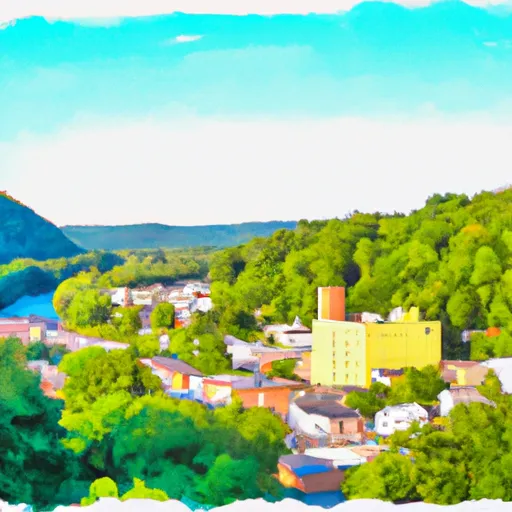-
 Snoflo Premium
Snoflo Premium
Get unlimited access to all our content
With no Ad interruptions! - Start Your Free Trial Login with existing account
Lackawaxen
Eden Index
Climate
7.4
•
Recreation
5.6
•
Community
•
Safeguard
4.9/10

Lackawaxen, Pennsylvania is a small, picturesque town located in Pike County. The town possesses a humid continental climate, with hot summers and cold winters. Summer temperatures range from the mid-70s to low 80s Fahrenheit, while winter temperatures hover around the 30s, with occasional drops below freezing. The area experiences moderate rainfall throughout the year, with July being the wettest month.
Hydrologically, Lackawaxen is situated at the confluence of the Delaware and Lackawaxen Rivers. The rivers provide scenic views and ample opportunities for water-based activities such as fishing, boating, and kayaking. The Lackawaxen River is well-known for its trout fishing, attracting anglers from near and far.
Outdoor recreation enthusiasts will find plenty to explore in Lackawaxen. The area is home to several state parks and nature reserves, offering opportunities for hiking, camping, and wildlife watching. One notable attraction is the Zane Grey Museum, celebrating the renowned author's life and love for fishing.
Overall, Lackawaxen's climate, hydrology constituents, and outdoor recreational opportunities make it an attractive destination for nature lovers and outdoor enthusiasts alike.
What is the Eden Index?
The Snoflo Eden Index serves as a comprehensive rating system for regions, evaluating their desirability through a holistic assessment of climate health, outdoor recreation opportunities, and natural disaster risk, acknowledging the profound impact of these factors on livability and well-being.
Climate Health Indicator (CHI): 7.4
Lackawaxen receives approximately
1109mm of rain per year,
with humidity levels near 80%
and air temperatures averaging around
9°C.
Lackawaxen has a plant hardyness factor of
6, meaning
plants and agriculture in this region thrive during a short period during spring and early summer. Most
plants will die off during the colder winter months.
By considering the ideal temperature range, reliable water supplies, clean air, and stable seasonal rain or snowpacks, the Climate Health Indicator (CHI) underscores the significance of a healthy climate as the foundation for quality living.
A healthy climate is paramount for ensuring a high quality of life and livability in a region, fostering both physical well-being and environmental harmony. This can be characterized by ideal temperatures, reliable access to water supplies, clean air, and consistent seasonal rain or snowpacks.
Weather Forecast
Streamflow Conditions
Upper Delaware
Area Rivers
Upper Delaware
Snowpack Depths
Upper Delaware
Reservoir Storage Capacity
Upper Delaware
Groundwater Levels
Recreational Opportunity Index (ROI): 5.6
The Recreational Opportunity Index (ROI) recognizes the value of outdoor recreational options, such as parks, hiking trails, camping sites, and fishing spots, while acknowledging that climate plays a pivotal role in ensuring the comfort and consistency of these experiences.
Access to outdoor recreational opportunities, encompassing activities such as parks, hiking, camping, and fishing, is crucial for overall well-being, and the climate plays a pivotal role in enabling and enhancing these experiences, ensuring that individuals can engage in nature-based activities comfortably and consistently.
Camping Areas
| Campground | Campsites | Reservations | Toilets | Showers | Elevation |
|---|---|---|---|---|---|
| Wilsonville Rec Area - PPL | None | 1,195 ft | |||
| Promised Land State Park | None | 1,746 ft | |||
| Swartswood State Park | 65 | 573 ft | |||
| Voorhees State Park | 45 | 752 ft | |||
| Worthington State Forest | 70 | 321 ft | |||
| Mohican Walk-In Campsites | 7 | 927 ft | |||
| Shotwell - Stokes State Forest | 25 | 811 ft | |||
| Dingmans - Delaware Water Gap National Rec Area | None | 412 ft | |||
| Beaverkill - DEC | None | 1,582 ft | |||
| Spruce Run Recreation Area | 65 | 309 ft |
Nearby Ski Areas
Catastrophe Safeguard Index (CSI):
The Catastrophe Safeguard Index (CSI) recognizes that natural disaster risk, encompassing floods, fires, hurricanes, and tornadoes, can drastically affect safety and the overall appeal of an area.
The level of natural disaster risk in a region significantly affects safety and the overall livability, with climate change amplifying these risks by potentially increasing the frequency and intensity of events like floods, fires, hurricanes, and tornadoes, thereby posing substantial challenges to community resilience and well-being.
Community Resilience Indicator (CRI):
The Community Resilience Indicator (CRI) recognizes that education, healthcare, and socioeconomics are crucial to the well-being of a region. The CRI acknowledges the profound impact of these elements on residents' overall quality of life. By evaluating educational resources, healthcare accessibility, and economic inclusivity, the index captures the essential aspects that contribute to a thriving community, fostering resident satisfaction, equity, and social cohesion.

